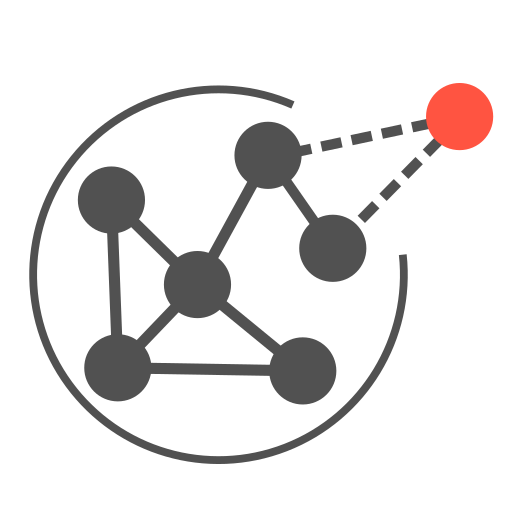Mechanisms¶
- class netin.TriadicClosure(n: int, f_m: float, tc: float, seed: object | None = None)¶
Class to model triadic closure as a mechanism of edge formation given a source and a target node.
Parameters¶
- n: int
number of nodes (minimum=2)
- f_m: float
fraction of minorities (minimum=1/n, maximum=(n-1)/n)
- tc: float
triadic closure probability (minimum=0, maximum=1)
- seed: object
seed for random number generator
Notes¶
This class does not generate a graph.
- get_metadata_as_dict() Dict[str, Any]¶
Returns the metadata (parameters) of the model as a dictionary.
Returns¶
- dict
metadata of the model
- get_target_probabilities(source: int, available_nodes: List[int]) Tuple[array, List[int]]¶
Returns the probabilities of selecting a target node from a set of nodes based on triadic closure, or a regular mechanism,
Parameters¶
- sourceint
source node
- available_nodesList[int]
list of available target nodes
Returns¶
- Tuple[np.array, List[int]]
Tuple of two equally sizes lists. The first list contains the probabilities and the second list the available nodes.
- get_triadic_closure() float¶
Returns the triadic closure probability tc.
Returns¶
- tc: float
triadic closure probability (minimum=0, maximum=1)
- infer_triadic_closure() float¶
Infers analytically the triadic closure value of the graph.
Returns¶
- float
triadic closure probability of the graph
- info_computed()¶
Shows the computed properties of the graph.
- info_params()¶
Shows the parameters of the model.
- init_special_targets(source: int) object¶
Returns an empty dictionary (source node ids)
Parameters¶
- sourceint
Newly added node
Returns¶
- object
Return an empty dictionary (source node ids)
- initialize(class_attribute: str = 'm', class_values: List[Any] | None = None, class_labels: List[str] | None = None)¶
Initializes the model.
Parameters¶
- class_attribute: str
name of the attribute that represents the class
- class_values: list
values of the class attribute
- class_labels: list
labels of the class attribute mapping the class_values.
- on_edge_added(source: int, target: int)¶
Updates the set of special available_nodes based on the triadic closure mechanism. When an edge is created, multiple potential triadic closures emerge (i.e., two-hop neighbors that are not yet directly connected). These are added to the set of special available_nodes.
Parameters¶
- idx_target: int
index of the target node
- source: int
source node
- target: int
target node
- available_nodes: List[int]
list of target nodes
- special_targets: Union[None, Dict[int, int]]
special available_nodes
Returns¶
- Union[None, Dict[int, int]
updated special available_nodes
- set_triadic_closure(tc: float)¶
Sets the triadic closure probability tc.
Parameters¶
- tc: float
triadic closure probability (minimum=0, maximum=1)
- validate_parameters()¶
Validates the parameters of the undirected.
- class netin.Homophily(n: int, f_m: float, h_MM: float, h_mm: float, seed: object | None = None)¶
Class to model homophily as a mechanism of edge formation given a source and a target node.
Parameters¶
- n: int
number of nodes (minimum=2)
- f_m: float
fraction of minorities (minimum=1/n, maximum=(n-1)/n)
- h_MM: float
homophily (similarity) between majority nodes (minimum=0, maximum=1.)
- h_mm: float
homophily (similarity) between minority nodes (minimum=0, maximum=1.)
Notes¶
This class does not generate a graph.
- get_homophily_between_source_and_target(source: int, target: int) float¶
Returns the homophily value between a source and a target node based on their class values. This homophily value is inferred from the mixing matrix.
Parameters¶
- source: int
Source node id
- target: int
Target node id
Returns¶
- h: float
homophily (similarity) between source and target nodes (minimum=0, maximum=1.)
- get_homophily_majority() float¶
Returns the homophily value between majority nodes.
Returns¶
- h_MM: float
homophily (similarity) between majority nodes (minimum=0, maximum=1.)
- get_homophily_minority() float¶
Returns the homophily value between minority nodes.
Returns¶
- h_mm: float
homophily (similarity) between minority nodes (minimum=0, maximum=1.)
- get_metadata_as_dict() dict¶
Returns the metadata info (input parameters of the model) of the graph as a dictionary.
Returns¶
- obj dict
dictionary with the metadata info of the graph.
- get_target(source: int, available_nodes: list[int], special_targets: None | object | iter) int¶
Picks a random target node based on the homophily dynamic.
Parameters¶
- source: int
Newly added node
- available_nodes: Set[int]
Potential target nodes in the graph
- special_targets: object
Special target nodes in the graph
Returns¶
int: Target node that an edge should be added to from source
- get_target_probabilities(source: int, available_nodes: list[int] | array) tuple[array, list[int]]¶
Returns the probabilities of selecting a target node from a set of nodes based on homophily. Homophily is inferred from the mixing matrix.
Parameters¶
- source: int
source node
- available_nodes: set[int]
set of target nodes
- special_targets: object
special available_nodes
Returns¶
- tuple[np.array, set[int]]
probabilities of selecting a target node from a set of nodes, and the set of target nodes`
- infer_homophily_values() tuple[float, float]¶
Infers analytically the homophily values for the majority and minority classes.
Returns¶
- h_MM: float
homophily within majority group
- h_mm: float
homophily within minority group
- info_computed()¶
Shows the computed properties of the graph.
- info_params()¶
Shows the parameters of the model.
- initialize(class_attribute: str = 'm', class_values: list | None = None, class_labels: list | None = None)¶
Initializes the model.
Parameters¶
- class_attribute: str
name of the attribute that represents the class
- class_values: list
values of the class attribute
- class_labels: list
labels of the class attribute mapping the class_values.
- set_homophily_majority(h_MM: float)¶
Sets the homophily value between majority nodes.
Parameters¶
- h_MM: float
homophily (similarity) between majority nodes (minimum=0, maximum=1.)
- set_homophily_minority(h_mm: float)¶
Sets the homophily value between minority nodes.
Parameters¶
- h_mm: float
homophily (similarity) between minority nodes (minimum=0, maximum=1.)
- validate_parameters()¶
Validates the parameters of the graph.
